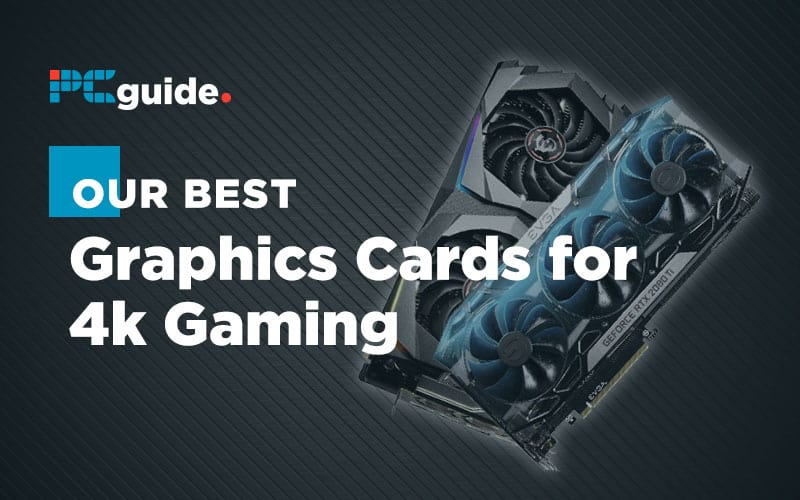Last Updated on
As 4k gaming starts to become the norm, you’re going to want a graphics card that is capable of the future high resolution AAA titles that get released. Of course, with graphics cards of this calibre, you’re going to need deep pockets, especially with options like the Nvidia RTX 2080 Ti and Nvidia RTX 2080 Super. However, with our selection of best graphics cards for 4k gaming, we’ve tried to pander to the needs of a variety of individuals – even including an Radeon option for you AMD lovers out there. There is a ‘budget’ option too, which may seem contradicting to my previous statement, but by budget, we mean at a lower cost compared to the high ticket graphics cards that are simply unobtainable for most users.
Best Performing 4k Gaming Graphics Card
Best Overall 4k Gaming Graphics Card
Best Value 4k Gaming Graphics Card
Best AMD 4k Gaming Graphics Card
Best Budget 4k Gaming Graphics Card
Our Verdict
Overall, when looking at all of our picks for the best graphics card for 4k gaming, we think you should go for the 2080 Super due to the price vs performance aspect. It gives you a boost clock of 1,860 MHz and 8GB of DDR6 SDRAM which is more than enough to handle the top AAA at 4k resolutions while also being much cheaper than the 2080 Ti. However, if you do want the top of the line graphics card that is also a little more future proof, spend the extra money on the 2080 Ti. You’re getting that boost in performance with an additional 3GB of RAM. If budget is your top priority, the RTX 2060 Super is still a great 4k gaming graphics card and will scratch that top resolution itch.
Additional Information
When choosing the best graphics card for 4k gaming, there are a number of different factors to take into account. If you didn’t understand any of the specifications given in the article above, or you just want a refresher on what they all mean, we’ve provided this section as a buying guide for your reference. Keep reading for a breakdown on each of the key specs we’ve provided, and what they mean to you as a consumer.
GPU Size
GPU Size refers to two different measurements. There’s length, in exact millimeters, and width, measured in slots. Slots refers to both the PCI Express slots that a GPU is inserted into and the slots in the chassis, while length refers to how far into the case the graphics card extends.
Of these two measurements, GPU length is the one that is more likely to cause compatibility issues, especially in a Micro ATX or Mini ITX PC build. Width is really only ever a concern if you plan on installing additional expansion cards, which has become much less necessary with improvements in motherboard I/O and USB adoption.
In any case, be sure to check GPU clearance measurements against those provided by the case manufacturer in specs. You wouldn’t want to buy a massive graphics card that you find out doesn’t fit on the day you’re assembling your build!
GPU Architecture
GPU architecture refers to the technology your GPU is built around. Every card in a certain GPU series will be built with the same architecture, starting with a “pure” version at the highest end. Understanding these will help you better understand the graphics card hierarchy.
Below, we’ve listed the relevant GPU architectures for consumers today:
AMD Polaris – Used by the RX 500 series, iterative upon past generations.
AMD Vega – Used by the RX Vega series and the Radeon VII, known for utilizing HBM2 and serving double duty as gaming and professional cards.
AMD Navi – AMD’s next-gen architecture. Likely to replace Vega and Polaris entirely.
Nvidia Pascal – Nvidia’s last-gen architecture, used by the GTX 10-Series.
Nvidia Turing – Nvidia’s current-gen architecture, enabling features like real-time ray-tracing in the RTX 20-Series. The GTX 16-Series is also based on this architecture, but without the extra processing cores for ray-tracing features.
Clock Speed
Clock speed isn’t very useful as a method of comparing different GPUs, especially not across different architectures. If you’re familiar with CPUs, it’s pretty much the same here: clock speed is generally only effective at comparing GPUs with the same architecture. In some cases, clock speed may only be useful for comparing different models of the same GPU, which further complicates matters.
A reference design of a graphics card is one released by the manufacturer as a baseline for others to work with. Nvidia and AMD both release reference designs, which are then iterated upon by companies like MSI and EVGA.
These new designs use aftermarket coolers and may even result in shorter or longer cards, as well as higher out-of-box clock speeds. When a card ships with an above-reference clock speed, this is referred to as a factory overclock, and you will find it is very common in the GPU market.
VRAM
VRAM refers to the memory used exclusively by your graphics card. This differs from standard memory, or RAM, used by the rest of your PC in a few key ways.
VRAM is mainly used for dealing with high resolutions, post-processing effects, and high-fidelity texture streaming. The more VRAM you have, the better your card will be at handling these things… as long as your card can keep up. The type of VRAM used can also be an influencing factor here.
VRAM types, from slowest to fastest:
GDDR5 – Used by AMD Polaris and Nvidia Pascal GPUs.
GDDR5X – Used by high-end Nvidia GPUs and low-end Turing GPUs.
GDDR6 – Used by midrange and high-end Nvidia Turing GPUs.
HBM2 – Used by AMD Vega cards and high-end Nvidia GPUs.
VRAM capacities and matching resolutions:
2GB – Suitable for 720p and 1080p in most scenarios.
4GB – Suitable for 1080p and 1440p in most scenarios.
6GB – Suitable for 1440p and VR in most scenarios. 4K needs GDDR6 or better.
8GB – Suitable for 1440p, VR, and 4K. The underlying GPU will need to be powerful enough to keep up, though.
In general, if you see two versions of the same card and one version has more VRAM go with that version. It’ll futureproof your system just a little bit more.
Resolution and FPS
When we talk about how each GPU performs, we’ll be mainly referring to its resolution and FPS, or framerate. Below, we’ll provide some explanation for common figures.
Additionally, note that the FPS you can actually see is limited by your display. Most displays only display up to 60 Hz, or 60 FPS. The same applies to resolution, though this is measured the same by games and displays.
Framerate targets:
30 FPS – Anything below this is considered unplayable. Not smooth, but not jittery either- just okay.
60 FPS – Smooth, and the smoothest that a 60 Hz refresh rate display can show. The ideal target in most scenarios.
100 FPS – Very smooth- a common compromise made by those with high refresh rate displays, who want smoother gameplay without totally sacrificing visuals.
120 FPS – Ultra smooth.
144 FPS and higher – As smooth at it gets.
Tech and Terms
In this section, we’re going to list a few common terms you might see tossed around in this article and in product reviews elsewhere.
V-Sync – V-Sync is used to prevent screen tearing when a game’s framerate exceeds a display’s refresh rate. This comes at the penalty of performance loss and more input latency.
G-Sync and FreeSync – An improved version of V-Sync, corresponding to Nvidia and AMD, respectively. Requires a compatible monitor to function properly.
Upscaling – The practice of rendering at a lower resolution and upscaling to a higher one. This is used by the upgraded consoles to achieve a 4K image, and is an option in many PC games. However, an upscaled image will never look as a good as a true, “native” image.
AA (Antialiasing) – Used to remove jagged edges from an image. Especially common and necessary at 1080p and lower resolutions, but becomes less of a hard requirement at higher resolutions.
SLI, NVLink, and CrossFire – Multi-GPU technologies that have mostly fallen out of favor and support. The first two are Nvidia, the third is AMD. NVLink is the best of the three, but only supported by the highest-end Nvidia GPUs.
Real-time ray-tracing – The big feature of the Nvidia RTX GPUs vs GTX GPUs. Looks great, but only supported by a few games. Should eventually come to AMD GPUs as well, but is a niche technology for now. (GTX 1060 and newer Nvidia GPUs now support this, but with horrific performance. Thanks, Nvidia!)
DLSS – An Nvidia-exclusive technology used by RTX GPUs. A form of anti-aliasing fuelled by AI deep learning, allowing far better image quality in supported games.


